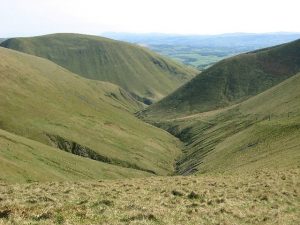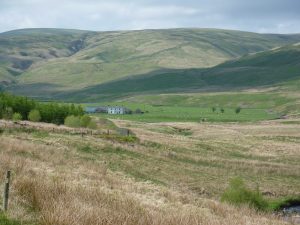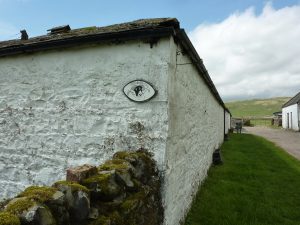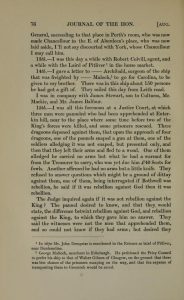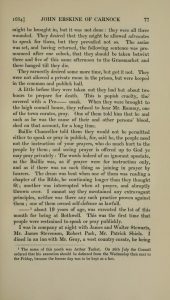I love no warres,
I love no jarres,
Nor strifes fire.
May discord cease,
Let’s live in peace;
This I desire.
If it must be,
Warre we must see
(So fates conspire),
May we not feel
The force of steel;
This I desire
T. Jackson 1651
On Tuesday 29th July 1684 a band of shepherds and farmers gathered to carry out a daring and selfless act. These men were ordinary hill-folk with no military training and little experience of firearms but they put themselves in danger by setting up an ambush of government dragoons to free fellow countrymen who were being sent to their deaths or into exile from which they would never return.
The Rescue
In Dumfries, in July 1684, sixteen men were tried and condemned to transportation. This usually additionally involved branding and or ears being cut off to mark them as miscreants. The prisoners were to be transported to Edinburgh where a ship belonging to Robert Malloch, a merchant, was waiting to sail. Malloch received £10 for each prisoner transported to Carolina. On Monday 28th July the prisoners, escorted by dragoons led by Sergeant Currie, were lodged in the tollbooth (prison) at Thornhill. There were two or three alternative routes which the party could take the next day on their way to Edinburgh. Locals heard that the route over the Enterkin Pass had been chosen and this information was passed on to a group who were already planning to rescue the prisoners. This group, reputed to consist of up to forty local ‘hillmen’, not trained soldiers but a hardy breed who farmed sheep and cattle on the local hills. They were reputedly led by James Harkness, son of the farmer in nearby Locherben. His brother Thomas and their cousins William Harkness from Mitchelslacks, and Luke and Thomas Fraser, or Frizzel as known locally, from Auchencairn Farm, along with youngsters Samuel MacEwen and Andrew Clerk were believed to be amongst the band.
The Enterkin Pass in 1684 was one of the main routes from South-West Scotland to the capital. It was a track too narrow and steep for wheeled transport but suitable for men on foot or horseback. At the top end of the track was Scotland’s highest village, Wanlockhead, and at this time the mine there was supplying lead for the roof of the Duke of Buccleuch’s new stately home, Drumlanrig Castle. Although the track was in good repair and well used with pack horses carrying lead, it could, even in summer, be a desolate and forbidding place. The exact location of the ambush is not known although evidence given by Patrick Milligan, an officer with the dragoons along with a witness, Alexander McMath, who had supplied the horses from a nearby farm, suggests it may have occurred where the track passes through a ravine with a steep slope above one side and an almost vertical drop into a gully carrying the Kelt burn on the other.
[box] “Patrick Milligan, officer in Thornhill, sworn, depones that he, being with the King’s partie, did sie the attack maid and did sie twa of the prisoners dragged efter the horses and that one of them seamed as dead, and the uther extreamlie wondit, and that the rebells wes divydit in the thrie pairties, one upon one syde of the way, one uther upon the uther syde and the third laigh in the cleuch and that efter the rebells fyred they clapt close among the brekinss”. Register of the Privy Council of Scotland. 3rd Series.
[/box] The prisoners were tied up on horse back and this would have been a dangerous place to carry out a rescue. However, it was a well chosen place for men on foot to confront mounted dragoons who would be unable to manoeuvre their horses in the confined space to attack their assailants.
[box] “Alexander McMath in Drumcruil aged 23 years, unmarried, depones that, following the horse that wes carrying the prisoners, he did see Robert Grier, chapman, and James Harkness, sometime in Locherben, amongst the rebells, who wes in thrie pairties, one upon the one syde of the hill the uther upon the uther syde of the way, the third laigh in the Glen, and thathe did sie one of the prisoners fall off the deponents horse and slipped down to the Glen, but knowes not whither he was killd or woondit, who saw himself to ——– and computes the number of rebells to be above twentie, and, as the deponent came down the hill, he met Robert Grier and James Harkness, who inquired quhat he was and whither he was going, quhich he accordingly told him, and knowes noe more, as he sall answer to God” Register of the Privy Council of Scotland. 3rd Series.[/box]
The dragoons appear to have been taken by surprise and the rescue a qualified success. Although at least two prisoners were killed or seriously injured, perhaps shot by dragoons, most escaped.
The Hunt
The Scottish government was shocked by the rescue. The South-West was living virtually under military dictatorship led by James Graham of Claverhouse, Bonnie Dundee, and the rescue was seen as a direct threat to the government’s authority. One of the most extensive criminal enquiries seen in Scotland, not surpassed in scale until the enquiry into the nearby Lockerbie air crash 300 years later, was instigated. Local sheriffs (magistrates) were ordered to interview every man, woman and child over the age of discretion (twelve years) to ascertain what they knew of the rescue and any of the suspects. It became clear that the Harkness brothers, James and Thomas were major suspects. Six days after the rescue a patrol of dragoons, reputedly led by Claverhouse himself, came across the Harkness brothers along with Samuel MacEwen and Andrew Clerk found hiding in Clauchrie Wood not far from Auchencairn farm, the home of their Fraser cousins. Circumstances suggest that their whereabouts were betrayed. Shots were fired and the fugitives captured. There was real concern that a further rescue might be mounted, even widespread revolt, so little time was wasted in taking the prisoners to Edinburgh. Claverhouse is alleged to have given the order that in the event of an attempted rescue the prisoners were to be shot. A sign of the government’s concern was the introduction of legislation giving the power to try, convict and execute ‘rebels’ the same day.[box] Bonnie Dundee – Bloody Clavers
“Our old people can talk of fairies, ghosts, mermaids and the de’il! Mercy on us, Sir, the de’il, with kindling ardour in their eyes, but the name of Claverhouse is never mentioned but with the utmost horror and reproach. How often when a child have I blessed in my heart the soldier who loaded his gun with a few sixpenny pieces and lodged them in the heart of that bloody persecutor”.
James Hogg the Ettrick Shepherd.
(Hogg is referring above to the legend that Claverhouse was killed at the Battle of Killiekrankie with a silver bullet)[/box]
A Form of Justice
The prisoners, injured and no doubt ill-treated were taken to Edinburgh and lodged in the Canongate Tolbooth, which still exists as a museum. There is no direct evidence of torture but it was common practice, indeed part of the judicial process at this time. Thumbscrews and the ‘Boot’, a device that used a cage and wedges to crush the victims leg, were commonly used to extract confessions of guilt. The archives of Scotland’s criminal records ( JC 39/53 http://www.nas.gov.uk/onlineCatalogue/) contain the ‘confessions’ of James, Thomas, Samuel and Andrew. They were examined by the Lord Justice General, Lord Linlithgow. All the prisoners were interrogated under oath, and therefore would be reluctant to lie, even to save their own lives. Most of the answers were evasive or in the case of being asked if they were at Enterkin, they refused to answer. Contrary to natural justice, and probably the law of Scotland even at that time, their refusal to deny involvement in a crime, was held to be proof of guilt.
The four men, Thomas and James Harkness, Andrew Clerk and Samuel MacEwen were interrogated on the 12th August 1684, and all refused to sign the record of the interrogations. Additions were later made to James and Samuel’s ‘confessions’ . James stating that he knew of a house near Auchencairnie but he would’nt say it was for sheltering rebels or that he had spoken with Thomas Fraser’s wife and ‘gott meat and drink out of his house’. Samuel, 17 years of age further stated that he was willing to state that he was not at Enterkin.
On Friday 15th August 1684 the trial took place in the High Court, Edinburgh, close to St. Giles Cathedral. The indictment is headed by a list of the four accused: –
“Thomas Harknes in Locherbane
James Harknes
Andrew Clerk somtyme in Leadhills in Crauford paroch
Samuel McKewan in Glencairn paroch
Thomas Wood in Kirkmichaell
all prisoners”
But for some unexplained reason the name of James Harkness had been crossed out – he was not put on trial with the others. The trial took place and Thomas Harkness, Andrew Clerk and Samuel McEwan were found guilty and condemned to be taken to the Grassmarket, Edinburgh between
“two and five o’clock in the afternoon and there to be hanged on a gibbet till they be dead and all their lands heritages tacks steddings roumes possessions goods and gear whatsoever to be forfeit and as cheat to our sovereign Lord and so which is pronounced for doom –
Given under our hands at Edinburgh this fifteenth of August 1684
Linlithgow
Foulis
Lockhart
Roger Hog”
Execution
The three young men, two of them teenagers, were taken to Edinburgh’s Tollbooth and a short time later on their last journey down the West Bow to the gallows in the Grassmarket. The gallows were a primitive but effective affair. The men, in turn, had to climb a ladder propped against a high cross beam and the noose put round their neck. Usually the condemned were allowed time to say a final prayer, but the hangman, Monro, pushed them off before they could make their peace with the God they professed to die for.
Their bodies may have been taken to the Magadalene Chapel in the nearby Cowgate before being buried in Greyfriars Churchyard
But there should have been four men on the gallows. The ringleader and brother of one of the condemned, captured and interrogated with them had been spared. Why? A question with no obvious answer even today.
There is an account of the trial and execution recorded at the time by an advocate who was not involved in the case, John Erskine of Lauder (See adjacent copies).
On 28th August Erskine further records that William Young of Evandale was executed having escaped from the Canongate Tolbooth with another ten prisoners, he being the only one recaptured.
The Historical Notices of Sir John Lauder of Fountainhall record that:
“22 August 1684 – The Tolbooth of the Canongate is broke; and 8 or 10 prisoners, on suspition of ther accession to rebellion, escapes.
The Toune of Edinburgh was threatenened for it by the Privy Counsell; and he who stood sentinell was, in a Counsell of War, sentenced to be shot, tho the escape was out at a window, and by passing throw the riggings of many houses; and so might be without his knowledge”.
No names are given of those who escaped but it is almost certain that James Harkness was amongst them. Later stories of the Scottish Covenanters give accounts of his escape from the Canongate Tolbooth but date it to September 1683. It is unlikely that James escaped twice from the Tolbooth.
Lauder also gives information of the fate of the hangman, Monro, who was later the same day of the execution thrown in the ‘Thief’s Hole’ along with his assistant MacKenzie, for severely beating a beggar – at least some justice was given that day.

